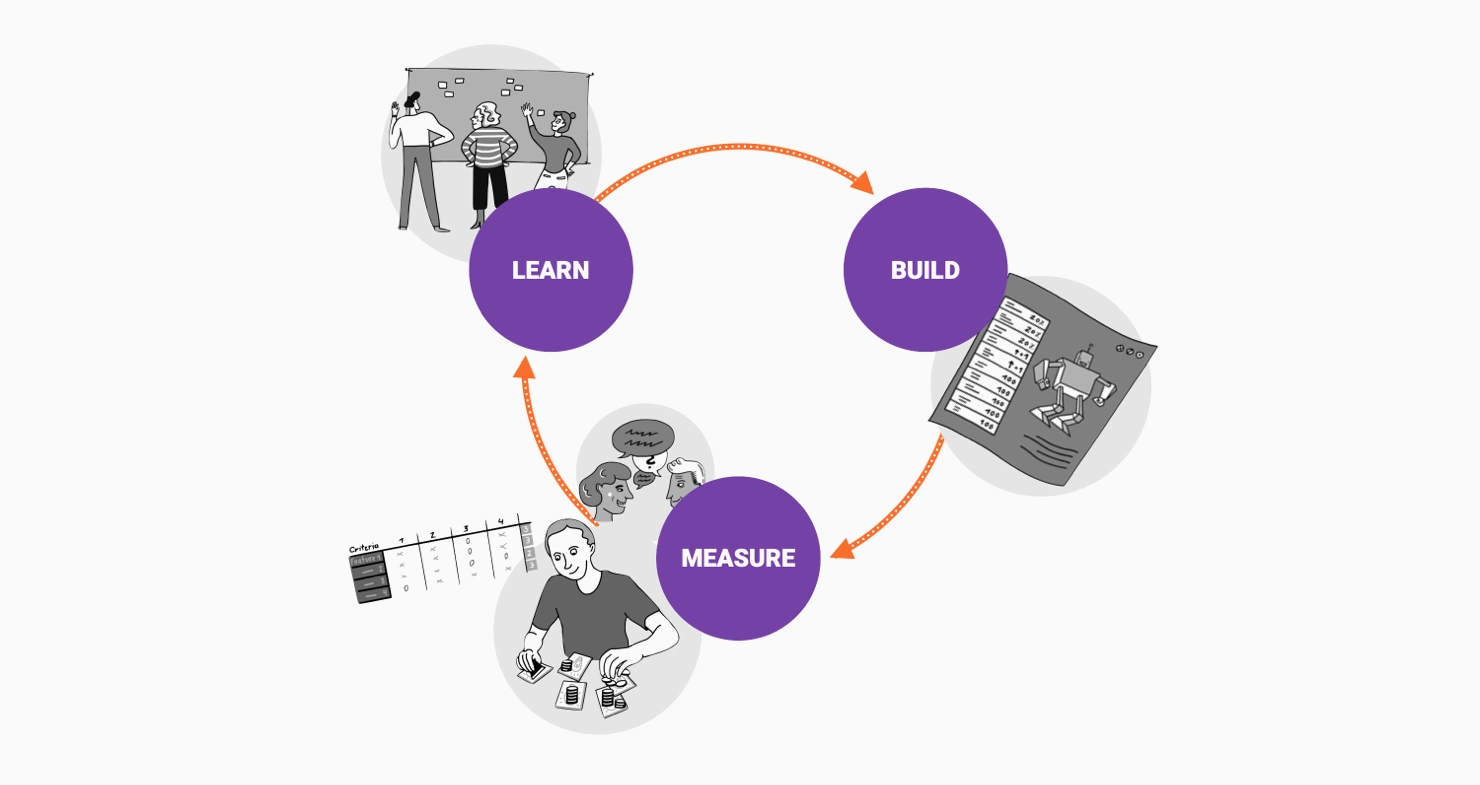In order to answer all the questions discussed, a Lean Startup team will act in the tradition of Lean Thinking and try to reduce the risks in all the previously mentioned risk dimensions through continuous experimentation and measurement until three so-called fits are achieved: Problem-Solution Fit, Product-Market Fit, and Business Model Fit. In the case of corporate startups, the Strategy Fit is added.
This is done through a process called the “Build-Measure-Learn” loop (strictly speaking, this should actually be called the Learn-Build-Measure loop, but that’s material for an extra article). So how does the loop work? Let’s take a look at a fictitious but real-world example:
Suppose a team wants to find out whether a potential buyer group would consider its startup’s novel industrial machine (solution) and sign a user agreement (VP/pricing test).
It would build for this now one or several controlled experiments to measure the behavior of the buyers without developing the machine already ready. What the team wants to find out is: Is the solution, as we would build it, attractive to the customer? If so: how can we elicit reliable signals from him about a willingness to pay?
For the first round of experiments, the team simply creates a spec sheet, pretends the machine already exists (build), and discusses with the buyer and/or user (and other influencers) in a first ‘sales pitch’ which performance parameters and features they will need and to what extent. Thereby it learns more about the needs (JTBD), pains, and gains of user and buyer. If necessary, it also asks for an initial willingness to pay (Measure). The important thing here is to create the illusion for the test subjects that the solution actually already exists. Why? Because the team wants to evoke and measure real, unbiased behavior. The team comes home with a lot of new information and also has initial confirmation of which features and especially selling points can be eliminated from the customer’s point of view and which still need to be added (learn). This is called a generative or exploratory round of testing. The whole thing only takes one to two weeks.

Let’s assume that the team has now learned that the customers would also be satisfied with 60% of the performance of your proposed solution but that you are still missing certain (technically minor) features that are important for both Purchasing and IT, whom they have to bring on board as the buying center because they release the contracts. So they changed the spec sheet accordingly and design a new experiment based on this. This time, however, the goal was to (in)validate a very specific hypothesis: “We believe that the current spec sheet configuration provides a more balanced balance of interests in the buying center. We are right if more than half of our leads could convince your buying center to sign a letter of intent saying to ‘quit’ the old solution in the new year.”
So this time, the team is only concerned with being right or wrong about this particular question. The experiment design is a so-called “Letter of Intent,” a common form in B2B that parties choose before signing a contract to show that they mean business. The team has 12 qualified leads in different companies from its experiment round one “Spec Sheet” that have signaled they are ready to take a next step. The team agrees that they can be confident that your solution is headed for product-market fit if they can get signatures from at least six companies with the updated specs. If there are fewer than six, the experiment is said to be a failure, and they need to rethink what the next step can be. This kind of experiment is often called evaluative research because it is not about opening new options or discovering things (explorative/generative, see above) but only about testing whether you are right or wrong in your assumptions (here: they are willing to exchange their old solution for ours and commit to us for X years at Y EUR). Evaluative experiments like these involving ink are a much stronger signal that the team is on the right track than, for example, verbal statements of intent in interviews (yet well-conducted interviews are the bread-and-butter of customer discovery in Lean Startup mode).
So both times, the team has gone through the learning loop of the Build-Measure-Learn loop and has been able to use the insights from the previous loop to build its next experiment. This also already roughly explains how the Lean Startup process works. But even though we won’t get into all the intricacies in this overview article, I want to go into a few more detailed steps. The questions that Lean Startup teams have to ask themselves are always the same:
- How can we externalize our implicit assumptions about how we think the world works, make them discussable and thus testable later?
- Which assumptions should we test first?
- How do you formulate a hypothesis from an assumption?
- And where do the ideas for the design of possible live experiments in the market come from?
In the next part of this article series, you will learn how a Lean Startup team answers these questions.
